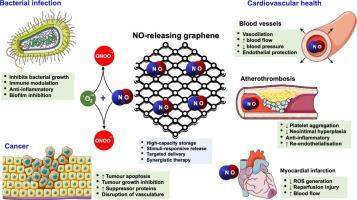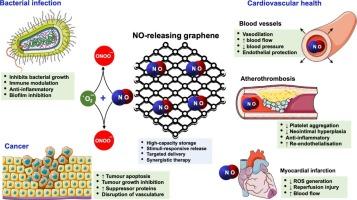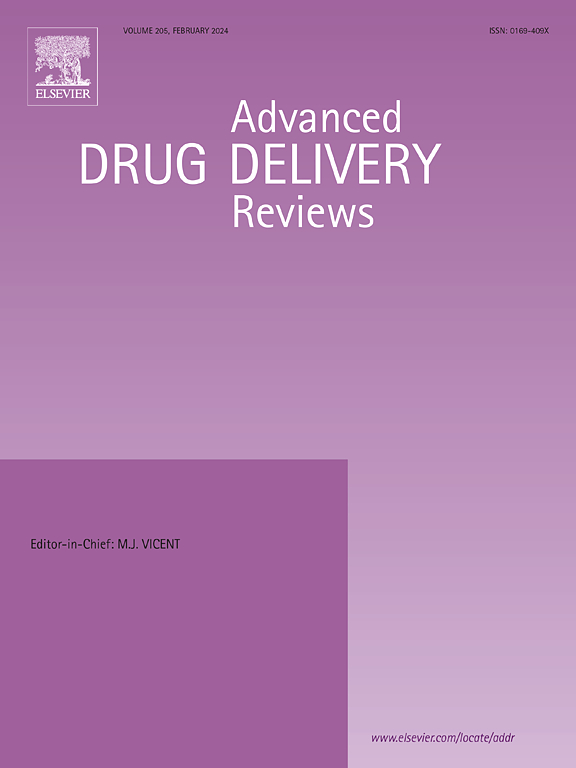Nitric oxide releasing graphene for next-generation therapeutics
IF 17.6
1区 医学
Q1 PHARMACOLOGY & PHARMACY
引用次数: 0
Abstract
Nitric oxide (NO) is a powerful signalling molecule and plays a central role in numerous physiological processes, most notably, in the cardiovascular, immune and central nervous systems. While organic nitrates, exemplified by nitroglycerin, have been used for over a century to deliver therapeutic NO, the search for novel drugs capable of selectively increasing NO bioavailability has continued unabated. Delivery of NO is hindered by its gaseous nature, extreme reactivity, short half-life and potential for systemic toxicity. To address these challenges, controlled NO delivery systems are highly desirable, offering precise release at the site of action over defined periods. Recent advances have focused on nanoparticles for injectable or implantable use, enabling sustained, targeted NO release while degrading safely. Among these, graphene nanostructures have emerged as efficient NO carriers, since they can be specifically designed to deliver NO gas or donor compounds due to their tunable surface chemistry, easy chemical modification and good biocompatibility. In this review, we discuss the latest developments in NO-releasing graphene formulations, alongside key applications in cardiovascular diseases, antimicrobial therapy and cancer treatment.


一氧化氮释放石墨烯用于下一代治疗
一氧化氮(NO)是一种强大的信号分子,在许多生理过程中起着核心作用,尤其是在心血管、免疫和中枢神经系统中。一个多世纪以来,以硝酸甘油为代表的有机硝酸盐一直被用于提供治疗性一氧化氮,但对能够选择性提高一氧化氮生物利用度的新药的研究仍在继续。一氧化氮的气体性质、极端的反应性、短半衰期和潜在的全身毒性阻碍了其给药。为了应对这些挑战,可控NO输送系统是非常可取的,可以在规定的时间内在作用部位精确释放。最近的进展集中在可注射或植入的纳米颗粒上,能够在安全降解的同时持续靶向释放NO。其中,石墨烯纳米结构已成为高效的NO载体,由于其表面化学可调,易于化学修饰和良好的生物相容性,可以专门设计用于输送NO气体或供体化合物。在这篇综述中,我们讨论了一氧化氮释放石墨烯配方的最新进展,以及在心血管疾病、抗菌治疗和癌症治疗中的关键应用。
本文章由计算机程序翻译,如有差异,请以英文原文为准。
求助全文
约1分钟内获得全文
求助全文
来源期刊
CiteScore
28.10
自引率
5.00%
发文量
294
审稿时长
15.1 weeks
期刊介绍:
The aim of the Journal is to provide a forum for the critical analysis of advanced drug and gene delivery systems and their applications in human and veterinary medicine. The Journal has a broad scope, covering the key issues for effective drug and gene delivery, from administration to site-specific delivery.
In general, the Journal publishes review articles in a Theme Issue format. Each Theme Issue provides a comprehensive and critical examination of current and emerging research on the design and development of advanced drug and gene delivery systems and their application to experimental and clinical therapeutics. The goal is to illustrate the pivotal role of a multidisciplinary approach to modern drug delivery, encompassing the application of sound biological and physicochemical principles to the engineering of drug delivery systems to meet the therapeutic need at hand. Importantly the Editorial Team of ADDR asks that the authors effectively window the extensive volume of literature, pick the important contributions and explain their importance, produce a forward looking identification of the challenges facing the field and produce a Conclusions section with expert recommendations to address the issues.

 求助内容:
求助内容: 应助结果提醒方式:
应助结果提醒方式:


